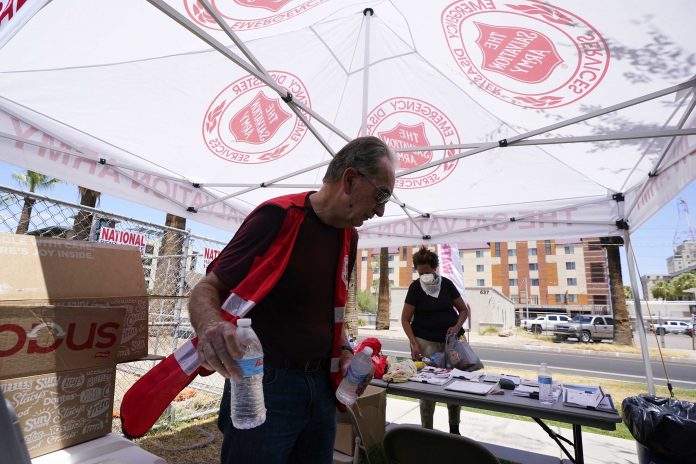
By ANITA SNOW
Associated Press
PHOENIX (AP) — This summer was the deadliest on record for heat-associated fatalities in Arizona’s largest county amid a growing wave of homelessness. Public health statistics this week confirmed a record 359 such deaths just days before the end of the six-month heat season.
The jump in deaths raises questions about how to better protect vulnerable people not only in the desert Southwest, where temperatures regularly hit triple digits, but also in more temperate areas where climate change has fueled more intense, frequent and enduring heat waves.
According to the National Weather Service, the highest temperature recorded this year at Phoenix Sky Harbor International Airport was 115 degrees (46.1 C) on July 11, with the mercury hitting 114 degrees (45.5 C) on June 11 and July 16 and 22.
Maricopa County’s heat-associated fatalities this year have outpaced the 339 deaths confirmed in 2021 and the final number could be higher still, with another 91 deaths still under investigation.
The county has more than a decade of experience tracking heat deaths, but comparable figures are hard to come by in other areas such as the Pacific Northwest, which has only experienced intense heat waves in recent years.
In California, researchers have found that unsheltered people — especially those with a mental illness — were significantly more likely to end up in the hospital during extreme heat than housed people, based on a study of emergency room admissions.
Nearly 80% of the heat-associated deaths in Maricopa County this year occurred outdoors, but the preliminary heat reports for this year don’t estimate how many of the deaths were among the homeless rather than people who were working outside or were outdoors for other reasons.
But the increase comes amid a surge in people living outside in metro Phoenix, with hundreds of homeless individuals sleeping in tents downtown amid soaring rents and evictions.
“With so many more homeless people, it makes sense that more would die in the heat,” said Amy Schwabenlender, executive director of the Human Services Campus in downtown Phoenix that brings together agencies assisting homeless people.
She said about 900 individuals currently stay at shelters on the campus, with about 1,000 more in tents on the streets outside the fenced property. There were an estimated 300 people sleeping just outside the campus a year ago.
Information about the role that substance use played in this year’s heat-associated deaths is not yet available.
But last year, substance use was a factor in 60% of those fatalities in Maricopa County. Methamphetamine was found in 91% of the deaths involving drugs, and fentanyl, an opioid, was found in 30%. While fentanyl is more likely to result in overdose, meth can create changes to the body that make a user more vulnerable to the heat, heightening the blood pressure, heart and respiratory rate
Homeless people accounted for 38% of the deaths involving drugs in 2021.
Males, African Americans, Indigenous Americans and those ages 75 and over had the highest rates of heat-associated deaths in the county in 2021.
David Hondula, director of the year-old Office of Heat Response and Mitigation for the city of the Phoenix, said in a report to City Council last week that his team is studying the numbers to understand what is behind the increase in deaths and how to plan for next summer.
Hondula said heat-related calls for assistance to the Phoenix Fire Department over the summer were expected to end up at least 10-20% above 2021.
The city fire department responded to 1,670 calls for service related to the heat between April 1 and September 30, a 13.6% increase over the same period in 2021. The highest density of calls came from Phoenix’s central and downtown urban areas.



















